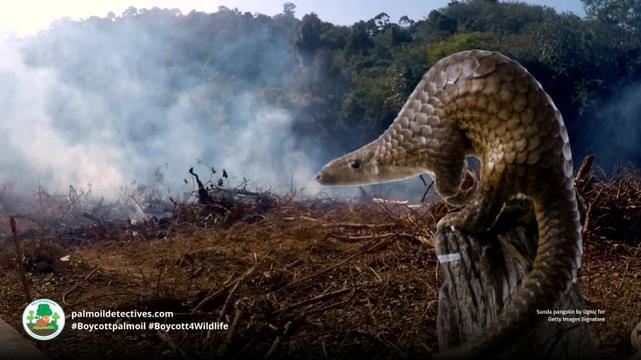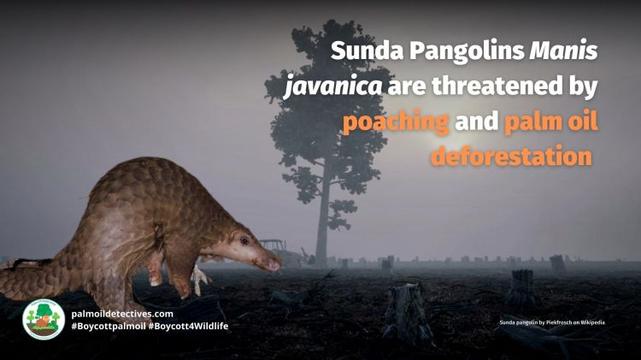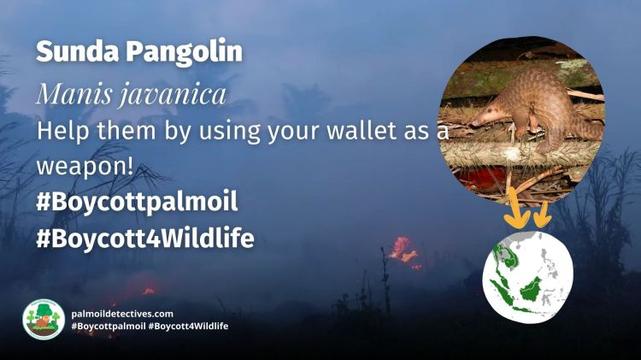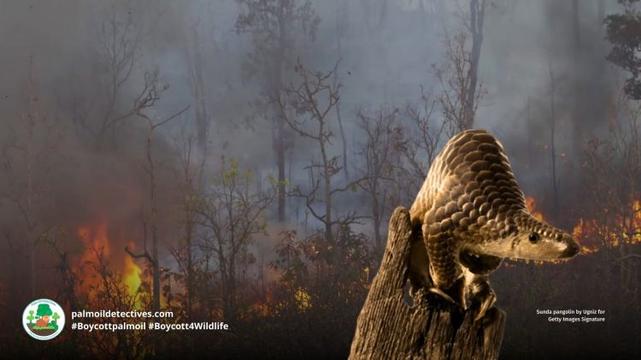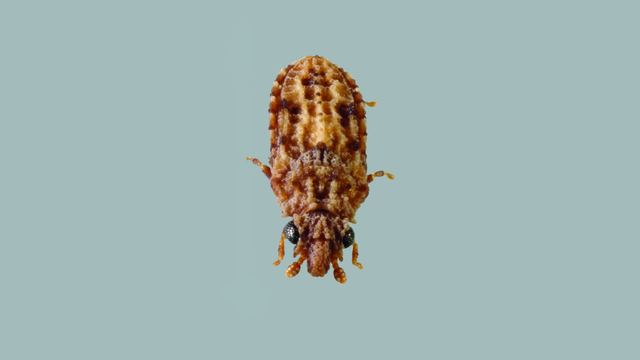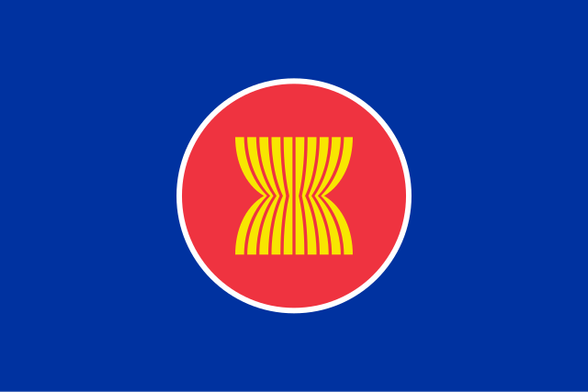Sunda Pangolin Manis javanica
Sunda Pangolin Manis javanica
IUCN Status: Critically Endangered
Extant (resident): Brunei Darussalam; Cambodia; Indonesia; Lao People’s Democratic Republic; Malaysia; Myanmar; Singapore; Thailand; Viet Nam
Presence Uncertain: China
Sunda #pangolins, also known as the Malayan or Javan pangolins, possess quirky traits that make them truly intriguing. They are capable swimmers and have a remarkable defense mechanism of curling into a protective ball, walk in an upside-down manner, and communicate through scale vibrations. As consummate insectivores, they rely on their long, sticky tongues to extract ants and termites from mounds. These pangolins have a slow metabolism, lack teeth but have a gizzard-like structure, and feature a specialised digestive system. To protect these unique creatures and their habitat, it’s crucial to take action. Join the movement and raise awareness about their primary threat #poaching and also by boycotting palm oil, which is also contributing towards their demise and putting them at risk of extinction. Help them every time you shop and be #vegan #Boycottpalmoil and #Boycott4Wildlife in the supermarket
Sunda #Pangolins have no teeth and their scales vibrate to help them communicate. They’re critically #endangered due to #palmoil #deforestation 🌴🔥🙊🚫 and #poaching in #Indonesia and #Malaysia. Help them when you shop! #BoycottPalmOil #Boycott4Wildlife https://palmoildetectives.com/2023/07/16/tbc-sunda-pangolin-manis-javanica/
Share to Twitter Share to BlueSkyFascinating #Sunda #Pangolins curl up like #pokemons 🏀🤯 to evade predators. They’re facing #extinction due to rampant #palmoil #deforestation and #poaching in South East Asia. Fight for them! #BoycottPalmOil 🌴🪔🩸💀⛔️ #Boycott4Wildlife @palmoildetect https://palmoildetectives.com/2023/07/16/tbc-sunda-pangolin-manis-javanica/
Share to Twitter Share to BlueSkySunda pangolins use a fascinating behaviour called “scale vibrations” to communicate with each other. By contracting and relaxing their muscles, they create subtle vibrations that can be sensed by other pangolins through their scales. These vibrations likely play a role in social interactions and mate selection.
Appearance & Behaviour
Here are some quirky facts about Sunda Pangolins which demonstrate their reign as one of the most fascinating creatures in the entire animal kingdom:
- Walking on the ceiling: Sunda pangolins have an interesting way of moving about. When they are on the ground, they walk on their hind legs with their forelimbs curled upwards. This peculiar method of locomotion is commonly referred to as the “upside-down walk.”
- Defensive and protective curl: When Sunda pangolins feel threatened, they have a unique defense mechanism. They curl up into a tight ball, using their scales as a protective armor. This posture makes it incredibly challenging for predators to attack them effectively.
- Consummate Insectivores: Sunda pangolins have an exceptionally specialised diet. They are insectivores, primarily feeding on ants and termites. Their long, sticky tongues, which can be longer than their body length, allow them to probe deep into termite mounds and anthills to extract their prey.
- Their scales vibrate: Sunda pangolins use a fascinating behaviour called “scale vibrations” to communicate with each other. By contracting and relaxing their muscles, they create subtle vibrations that can be sensed by other pangolins through their scales. These vibrations likely play a role in social interactions and mate selection.
- They have no teeth: Unlike most #mammals, Sunda pangolins lack teeth. However, they possess a muscular stomach and a unique adaptation known as a gizzard-like structure. They swallow small stones or grit, which aids in grinding up their insect prey within the digestive system.
- They have a slow Metabolism: Sunda pangolins have a relatively slow metabolism, which contributes to their low energy requirements. This metabolic trait allows them to survive on a diet consisting mainly of insects, which provide them with the necessary nutrients and energy.
- Their unusual digestive system: The digestive system of Sunda pangolins is adapted to handle their specialised diet. It features a long and complex intestine to maximize nutrient absorption, enabling them to extract as many nutrients as possible from the insects they consume.
Threats
Sunda Pangolins are heavily threatened and are now critically endangered. Their main threat is from hunting and poaching for local and international use. Their secondary threat is habitat destruction across their range for palm oil, timber and other crops.
- Demand comes from China and Vietnam: this drives the illegal trade in poaching, involving large quantities of live and dead animals, meat, and scales. Sophisticated trade routes exist over land and sea, contributing to the decline of Sunda Pangolin populations.
- Palm oil deforestation in Indonesia and Malaysia: accelerates poaching with increased access to animals from deforestation activities.
- Indonesia is a major source of illegal exports: involving live pangolins and meat, especially since 2000.
- Pangolin meat is consumed as a luxury product: in high-end urban restaurants, and scales are used in traditional medicine.
- Illegal trade is supported by insufficient legal protection in SE Asia.
- Snaring, accidental mortality, and injuries pose risks due to pervasive hunting practices in South East Asia.
Take action to protect the Sunda Pangolin and their habitat and #Boycottpalmoil #Boycott4Wildlife in the supermarket.
Habitat
Sunda pangolins (Manis javanica) are found across Southeast Asia. Their range includes countries such as Myanmar, Thailand, Cambodia, Laos, Malaysia, Singapore, Vietnam, and the islands of Borneo, Java, Sumatra, and the Lesser Sunda Islands.
In terms of habitat, Sunda pangolins prefer forested environments, including primary, secondary, and scrub forests. They can also be found in plantations such as rubber and palm oil plantations. These pangolins have adapted to spend a significant portion of their lives in trees, making use of their prehensile tails for climbing.
Diet
Sunda pangolins primarily feed on ants and termites, making them insectivores. Their diet consists mainly of these small invertebrates. They use their long, sticky tongues to probe into termite mounds and ant hills, collecting the insects as their main source of sustenance. The lack of teeth in pangolins is compensated by their specialised tongues and digestive system, which are well-adapted to consuming large amounts of ants and termites. This diet of ants and termites provides the necessary nutrients and energy for Sunda pangolins to thrive in their natural habitats.
Mating and breeding
Pangolins are fascinating creatures that give birth to one or two offspring annually. Their breeding season takes place in autumn, and females carefully select winter burrows where they give birth. They prefer mature forest tree hollows for added fortification and stability during the birthing and nurturing process.
Parental care lasts for about three months, during which the mother’s range significantly decreases as she travels and forages alongside her young. Only in the weeks before the offspring becomes independent, brief bursts of diurnal activity may be observed. Pangolins are typically solitary and nocturnal, using their ability to roll into protective balls to safeguard their vulnerable underparts when feeling threatened.
They are skilled diggers, creating burrows lined with vegetation near termite mounds and ant nests for insulation. Sunda pangolins are believed to engage in polygynous breeding, with males mating with multiple females.
The gestation period lasts around 130 days, and newborn pangolins have soft scales that harden shortly after birth. Weighing between 100 to 500 grams, the young are nursed by the females for three months, who display strong protective behaviour. During their travels and foraging, the baby pangolins often ride on their mother’s tail, and when danger looms, the mother instinctively curls up into a tight ball, providing a secure haven for her young.
Support Sunda Pangolins by going vegan and boycotting palm oil in the supermarket, it’s the #Boycott4Wildlife
Support the conservation of this species
This animal has no protections in place. Read about other forgotten species here. Create art to support this forgotten animal or raise awareness about them by sharing this post and using the #Boycottpalmoil #Boycott4Wildlife hashtags on social media. Also you can boycott palm oil in the supermarket.
Further Information
Challender, D., Willcox, D.H.A., Panjang, E., Lim, N., Nash, H., Heinrich, S. & Chong, J. 2019. Manis javanica. The IUCN Red List of Threatened Species 2019: e.T12763A123584856. https://dx.doi.org/10.2305/IUCN.UK.2019-3.RLTS.T12763A123584856.en. Accessed on 02 June 2023.
Sunda Pangolin on Wikipedia – https://en.wikipedia.org/wiki/Sunda_pangolin
Sunda Pangolin on Animalia.bio – https://animalia.bio/sunda-pangolin
How can I help the #Boycott4Wildlife?
Take Action in Five Ways
1. Join the #Boycott4Wildlife on social media and subscribe to stay in the loop: Share posts from this website to your own network on Twitter, Mastadon, Instagram, Facebook and Youtube using the hashtags #Boycottpalmoil #Boycott4Wildlife.
2. Contribute stories: Academics, conservationists, scientists, indigenous rights advocates and animal rights advocates working to expose the corruption of the palm oil industry or to save animals can contribute stories to the website.
Mel Lumby: Dedicated Devotee to Borneo’s Living Beings
Anthropologist and Author Dr Sophie Chao
Health Physician Dr Evan Allen
The World’s Most Loved Cup: A Social, Ethical & Environmental History of Coffee by Aviary Doert
How do we stop the world’s ecosystems from going into a death spiral? A #SteadyState Economy
3. Supermarket sleuthing: Next time you’re in the supermarket, take photos of products containing palm oil. Share these to social media along with the hashtags to call out the greenwashing and ecocide of the brands who use palm oil. You can also take photos of palm oil free products and congratulate brands when they go palm oil free.
https://twitter.com/CuriousApe4/status/1526136783557529600?s=20
https://twitter.com/PhillDixon1/status/1749010345555788144?s=20
https://twitter.com/mugabe139/status/1678027567977078784?s=20
4. Take to the streets: Get in touch with Palm Oil Detectives to find out more.
5. Donate: Make a one-off or monthly donation to Palm Oil Detectives as a way of saying thank you and to help pay for ongoing running costs of the website and social media campaigns. Donate here
Pledge your support#animals #Boycott4wildlife #BoycottPalmOil #Brunei #Cambodia #CriticallyEndangeredSpecies #deforestation #endangered #extinction #ForgottenAnimals #hunting #Indonesia #Laos #Malaysia #Mammal #mammals #mining #PalmOil #palmOilDeforestation #palmoil #Pangolins #poaching #pokemon #pokemons #singapore #Sunda #SundaPangolinManisJavanica #TemminckSPangolinSmutsiaTemminckii #Thailand #vegan #Vietnam
